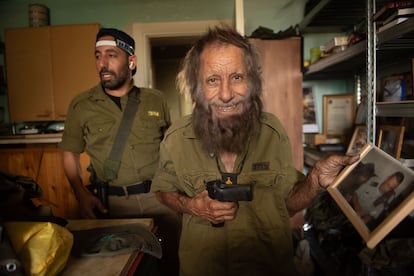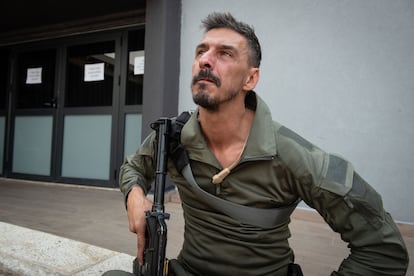Caught in the crossfire in a ghost town in northern Israel
The army has ordered the evacuation of the 23,000 inhabitants of Kiryat Shmona, located between Lebanon and the Golan Heights, but some residents refuse to go, saying they have been through other wars before


The drums of war sounded on Monday in the Galilee Panhandle, the territory located in the far north of the state of Israel and sandwiched in between the Lebanese border and the Golan Heights, the plateau occupied by the army since 1967. “It looks like a Katiusha [the rockets used by the Lebanese party-militia Hezbollah],” said Aviva Rihan-Whitman, 52, a councilor in the town of Kiryat Shmona, as she ran to take shelter under the concrete porch of the municipal civic center. “Ah no! These are our guys,” she added a moment later, smiling confidently while the sharp sound of artillery echoed like a kettledrum among the hills.
Rihan-Withman, a sociologist by trade, has been organizing the evacuation of the 23,000 residents of Kiryat Shmona, decreed on Friday by the army due to the growing confrontation with Hezbollah, which has claimed the lives of at least six Israelis and more than 35 Lebanese citizens since the conflict broke out on October 7. Another 42 towns have also received evacuation orders, although many people are reluctant to leave their homes.
“If Hezbollah decides to enter the war, it will miss the Second Lebanon War. That would be its biggest mistake ever,” warned Israeli Prime Minister Benjamin Netanyahu on Sunday, alluding to the pro-Iran militia operating on the Lebanese border and to a 2006 conflict that claimed the lives of 1,300 Lebanese and 165 Israelis in 33 days of fighting. The deployment of Merkava tanks, artillery batteries and infantry battalions has been evident in the border region of the Upper Galilee region for two weeks. The possibility of a deluge of rockets from southern Lebanon, where Hezbollah has more than 200,000 projectiles, is worrying the General Staff of the Israeli Armed Forces, which wants to avert the threat hanging over tens of thousands of civilians.
“Half of the residents of Kiryat Shmona have already left by their own means or in chartered buses to relatives’ homes or hotels paid for by the government,” said the councilor, who heads the social services department in a city that now resembles a ghost town, with schools and most businesses closed. “A quarter of the residents — elderly, families without financial resources or people without relatives — need help to leave town. The rest simply don’t want to leave,” says Rihan-Withman.
“That is not accurate. There are almost half of us who are going to stay, no matter what happens,” says David Hatani, 66, who worked in a hotel until his recent retirement. Born in Kiryat Shmona into a Jewish family that had just emigrated from Morocco, he remembers that when he was 10 years old, a Syrian mortar shell took the life of his classmate at school. “Since then I have seen all the wars right here from my house: the Six-Day War [1967], the Yom Kippur War [1973] and the two wars in Lebanon [1982 and 2006],” he says to justify his decision not to evacuate despite the order given by the military authorities.
David Hatani is a Torah-observant Jew who takes a dim view of “the promiscuity between secular and religious people” and the absence of kosher food in the hotels where the displaced population is being taken. He is not alone, although the decision to stay in a zone of hostilities seems risky. The air raid sirens wailed at 4:30 p.m. on Monday in Kyriat Shmona, shortly after an armed group opened fire on the Misgav Am kibbutz, which is isolated on top of a hill and surrounded by fences and barbed wire to separate it from Lebanese territory. An army spokesman reported shortly later that artillery had responded with several salvos directed at the point of origin of the fire, and that two “terrorist units” had penetrated a nearby area known as Shebaa Farms, a territory disputed between Lebanon and Israel.

“I’m not leaving either,” says Shlomo Elhag, 85, a retired non-commissioned officer of the Armed Forces who has been through all the wars of Israel, including the one that followed its creation in 1948. Together with his son Ishashi, a 42-year-old construction contractor who is serving as a reservist despite no longer being under the legal obligation to do so, he stands guard at home. The house stands halfway up the hill that marks the territorial boundary with Lebanon. “My mother and my sisters have been evacuated, along with other family members, but my brothers, sons and nephews are all patrolling the city now,” says Ishashi Elhag, with an M-16 assault rifle draped over his uniform.
The army has sealed off access to Metula, the northernmost point of the Galilee Panhandle, surrounded by Lebanese territory on all cardinal points except the south. One of the last towns whose evacuation has been ordered by the army is Hagoshrim, around seven miles (12 km) northeast of Kiryat Shmona. A checkpoint blocks the way to the fenced area of town, where about 1,300 people were living until now. There are only 200 left. Among them are Sheila’s octogenarian parents. This 57-year-old teacher at a high school in Haifa, the main city in northern Israel, shows “respect” for her parents’ decision. “I have asked them to come with me, but they prefer to remain at home, no matter what happens.”
“There are many people in Israel who think that this war must be stopped,” she declares with the conviction of a teacher explaining a lesson to her students. “Many of us believe that we have to seek an agreement to live in peace with the Palestinians.”
Meanwhile, nearly 120,000 civilians have fled the Lebanese territory controlled by Hezbollah in the past two weeks, according to the United Nations. The figure is similar to the number of evacuees within Israel near the Gaza Strip, in anticipation of a ground operation against Hamas, and along the northern border, where fewer and fewer civilians remain in the face of the eventual confrontation with Hezbollah.
Sign up for our weekly newsletter to get more English-language news coverage from EL PAÍS USA Edition
Tu suscripción se está usando en otro dispositivo
¿Quieres añadir otro usuario a tu suscripción?
Si continúas leyendo en este dispositivo, no se podrá leer en el otro.
FlechaTu suscripción se está usando en otro dispositivo y solo puedes acceder a EL PAÍS desde un dispositivo a la vez.
Si quieres compartir tu cuenta, cambia tu suscripción a la modalidad Premium, así podrás añadir otro usuario. Cada uno accederá con su propia cuenta de email, lo que os permitirá personalizar vuestra experiencia en EL PAÍS.
¿Tienes una suscripción de empresa? Accede aquí para contratar más cuentas.
En el caso de no saber quién está usando tu cuenta, te recomendamos cambiar tu contraseña aquí.
Si decides continuar compartiendo tu cuenta, este mensaje se mostrará en tu dispositivo y en el de la otra persona que está usando tu cuenta de forma indefinida, afectando a tu experiencia de lectura. Puedes consultar aquí los términos y condiciones de la suscripción digital.
More information

Israel’s military presses Netanyahu to launch Gaza invasion
Archived In
Últimas noticias
Most viewed
- Reinhard Genzel, Nobel laureate in physics: ‘One-minute videos will never give you the truth’
- Oona Chaplin: ‘I told James Cameron that I was living in a treehouse and starting a permaculture project with a friend’
- Pablo Escobar’s hippos: A serious environmental problem, 40 years on
- Why we lost the habit of sleeping in two segments and how that changed our sense of time
- Chevy Chase, the beloved comedian who was a monster off camera: ‘Not everyone hated him, just the people who’ve worked with him’









































